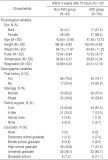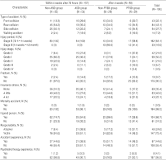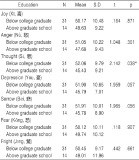Argonet WEB
- KOREAN
- ESCI, SCIE, KCI Candidate, SSCI, SSCI, A&HCI, KCI Candidate, A&HCI, KCI, SCOPUS
Vol.32 No.1

Abstract
Objectives:To investigate the prevalence of acute stress disorder (ASD) and post-traumatic stress disorder (PTSD) in patients with traffic injuries. In addition, PTSD patients was classified using ‘pattern identification for jing ji and zheng chong'.Methods:Questionnaires such as the primary care PTSD screen for DSM-5(PC-PTSD-5), Korean version of PTSD checklist-5 (PCL-5-K), and the instrument of pattern identification for jing ji and zheng chong were conducted on 195 patients within 3 days to 1 year after traffic accidents. Patients were recruited from six medical institutions. Collected data were used to determine the prevalence of acute stress disorder and post-traumatic stress disorder.Results:On PC-PTSD-5, the prevalence was 39.1% for ASD and 50% for PTSD. On PCL-5-K, the prevalence was 20.4% for ASD and 29.3% for PTSD. Satisfying both PC-PTSD-5 and PCL-5-K, the prevalence was 18.2% for ASD and 25.8% for PTSD. As a result of pattern identification for jing ji and zheng chong, ‘weakness of heart and gall bladder type’ accounted for the highest proportions in both ASD and PTSD groups.Conclusions:In this study, the prevalence was 39.1% for ASD and 50% for PTSD by PC-PTSD-5. Satisfying both PC-PTSD-5 and PCL-5-K, the prevalence was 18.2% for ASD and 25.8% for PTSD. Further large-scale prospective studies are needed to analyze the prevalence of ASD and PTSD, the rate of progression from ASD to PTSD, and the type of pattern identification.







Abstract
Objectives:This study was conducted to investigate the emotional characteristics of adults who complained of fatigue using the Core Seven Emotion Inventory-Short Form (CSEI-s) followed by correlation analysis with the Chalder fatigue scale (CFQ) and Psychosocial Well-being Index-Short form (PWI-SF).Methods:In this study, the medical records of 45 participants who complained of fatigue and completed the CSEI-s, CFQ, and PWI-SF were evaluated. Records of a total of 45 adults were analyzed using SPSS (Statistical Package for the Social Sciences, Version 25.0). Frequency Analysis, Descriptive Analysis, Independent t-test, One Way ANOVA, and Correlation analysis were used for data analysis.Results:1. According to the educational status of the participants, Thought (思) was identified to be significantly higher in below college graduate than in graduate school and above. 2. As the period of complaining of fatigue increased, a significant difference was observed in Depression (憂) and Fright (驚). 3. According to the degree of fatigue, there was a significant difference in Depression (憂) and Fright (驚), and especially Depression (憂) was higher in the middle fatigue group than in the low fatigue group. 4. PWI-SF, Anger (怒), Depression (憂), and Sorrow (悲) showed a positive correlation with CFQ scores.Conclusions:The results suggest that CSEI-s can be used to measure the psychological symptoms of a patient with fatigue.












Abstract
Objectives:Depression is a mood disorder showing low energy, loss of interest, anhedonia, and anxiety. It affects a patients' daily life. This disease is considered a social problem because the patient may commit suicide in extreme cases. JSB is composed of 12 Korean medicinal herbs. It has been prescribed to patients with depression. The objective of this study is to investigate anti-depressive effects of JSB on restraint stress-induced depression in a mouse model.Methods:Depression was induced by restraint stress. Mice were orally administered JSB at 10, 20, or 40 mg/kg for 14 days. Forced swimming test (FST) and open field test (OFT) were performed. Brain-derived neurotrophic factor (BDNF) mRNA level was measured by real time-PCR. Plasma levels of corticosterone and serotonin were measured by ELISA. Blood levels of AST and ALS were measured using a biochemical analyzer.Results:JSB treatment significantly reduced the immobility time in FST. BDNF mRNA level was increased by JSB treatment in the hippocampi of mice. Although the expression of TNF-α was also increased by JSB, such increase was not statistically significant. The increase of corticosterone level in plasma induced by restraint stress was significantly down-regulated by JSB. JSB reduced blood level of AST, but not ALT.Conclusions:JSB has a potential to manage depression, setting a foundation for clinical application of Korean medicine with safety.









Abstract
Objectives:To analyze the reports of qualitative research about natural disasters in Korea.Methods:Nine published qualitative research studies were selected for the analysis. The selected reports were analyzed by Consolidated Criteria for Reporting Qualitative Research (COREQ), a reporting guideline for qualitative research. In addition, each subject of the study was qualitatively synthesized.Results:In the quality assessment using COREQ, detailed information about the researchers were insufficient. The results of the studies were integrated into six themes: “Disaster experience”, “Disaster damage”, “Dealing with disasters”, “Disaster compensation issues”, “Arbitration Resources”, and “Post-disaster change”.Conclusions:In further qualitative research on natural disasters, it is necessary to report the research according to the COREQ checklist. Based on the results of this study, continuous attention and research are needed to explore the areas of Korean medicine care in the event of a disaster.






Abstract
Objectives:The aim of this scoping review was to analyze research trends about mental health of nurses working in Korean medicine (KM) hospitals in Republic of Korea.Methods:Searches were conducted using four electronic databases including Oriental Medicine Advanced Searching Integrated System, Korean Studies Information Service System, Research Information Sharing Service, Korea Citation Index to collect relevant studies. The search date was March 4, 2021. All studies published up to the search date were considered. Observational studies reporting mental health outcomes of nurses working at KM Hospital were included.Results:A total of 11 cross-sectional observation studies were included. Four of them compared mental health of nurses working on KM and Western medicine (WM). Commonly reported outcomes related to mental health were job satisfaction, role conflict, and work stress. As a result of meta-analysis based on a 5-point Likert scale, the following factors were related to mental health of KM nurses: job satisfaction (2.844±0.067 points), role conflict (3.678±0.058 points), work stress (3.142±0.021 points), turnover intention (3.483±0.028 points), and burnout (3.180±0.033). Compared to WM nurses, KM nurses had significantly less work stress (p=0.000), role conflict (p=0.039), and job satisfaction (p=0.000).Conclusions:Mental health problems of nurses are known to be very common. Although improving them is an important social task, studies on mental health of KM nurses remain insufficient. Based on findings of this study, more cooperation between nurses and KM doctors should be made to improve the mental health of KM nurses, especially their job satisfaction in the future. The Korean Society of Oriental Neuropsychiatry needs to pay more attention to this topic.






Abstract
Objectives: The purpose of this study was to report the effect of Korean medicine treatment on a patient with somatic symptom disorder hospitalized after a traffic accident. Methods: The subject for this study was a patient diagnosed with somatic symptom disorder that worsened after a traffic accident. During hospitalization, herbal medicine, acupuncture, psychotherapy, and other treatments were performed. Clinical effect was evaluated using Heart Rate Variability (HRV), BDI (Beck Depression Inventory)-II, BAI (Beck Anxiety Inventory), Global assessment (G/A), and Numerical rating scale (NRS). Results: After 36 days of treatment, BDI-II score was reduced from 17 to 5. BAI score was reduced from 23 to 8. Overall somatic symptoms and pain showed decreases. Conclusions: Korean medicine treatment might be effective for somatic symptom disorder that is worsened after a traffic accident.





